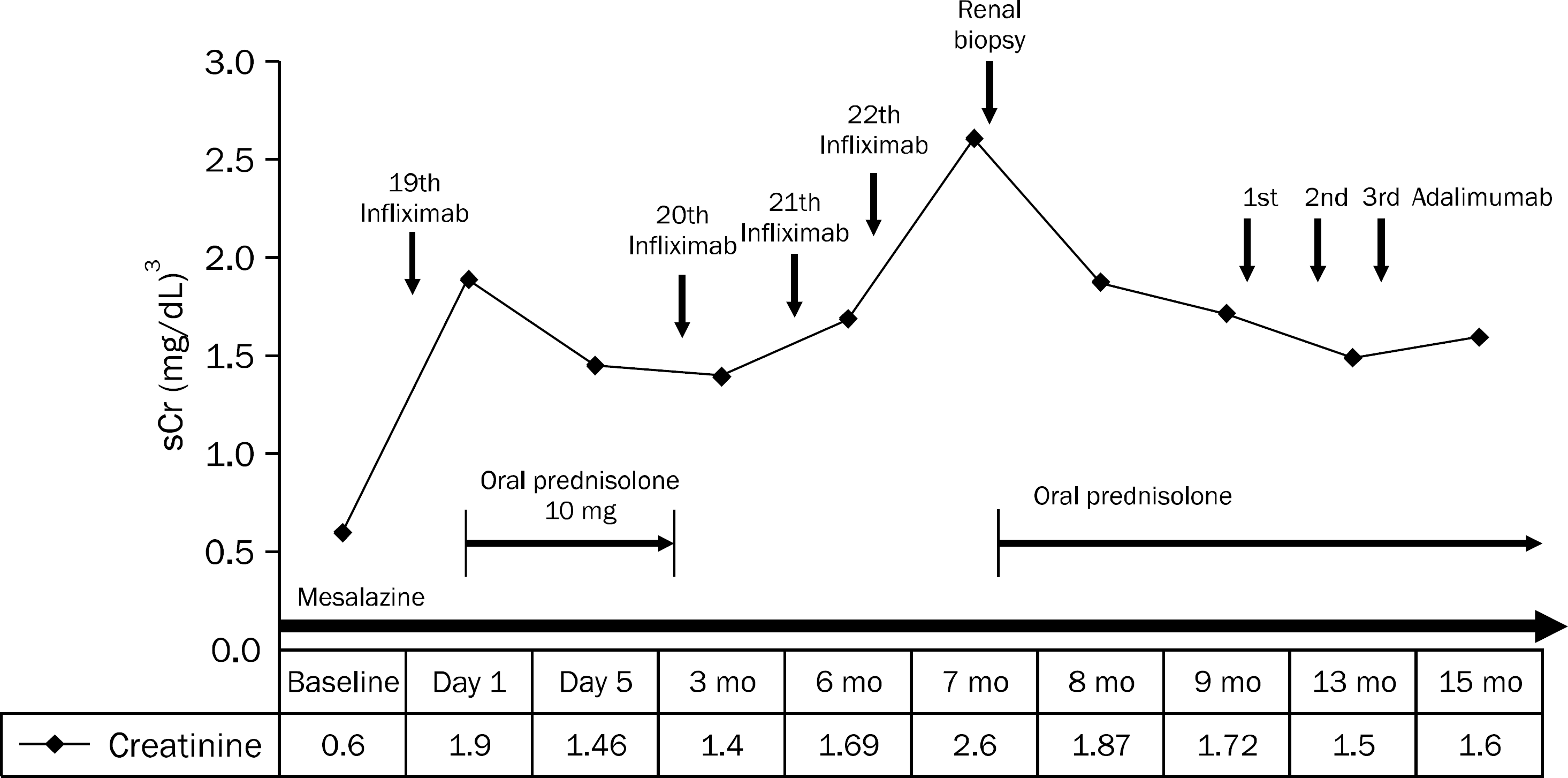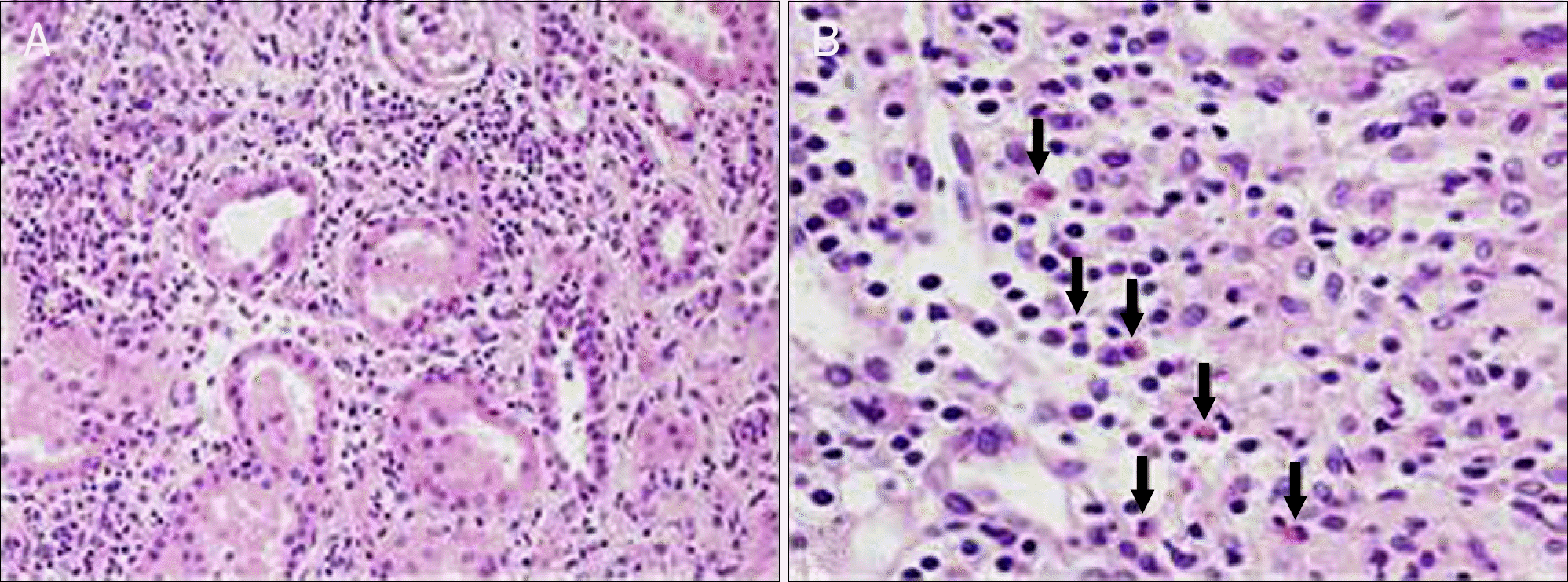Abstract
Infliximab is a chimeric anti-tumor necrosis factoralpha monoclonal antibody. Infusion related reactions and infection are well known side effects of infliximab; however, renal complications have not been well recognized. We report on a patient with late onset-acute tubulointerstitial nephritis (ATIN) after treatment with infliximab and mesalazine for Crohn's disease. A 25-year-old woman was admitted with a purpuric rash on both lower extremities and arthralgia. She had been diagnosed with Crohn's disease 5.6 years previously and had been treated with mesalazine and infliximab. Serum creatinine level, last measured one year ago, was elevated from 0.6 mg/dL to 1.9 mg/dL. Results of urinalysis, ultrasound, and serologic examinations were normal. With a tentative diagnosis of Henoch-Schönlein purpura, oral prednisolone was given, and serum creatinine decreased to 1.46 mg/dL, but was elevated to 2.6 mg/dL again at two months after discontinuation of prednisolone. Renal biopsy indicated that ATIN was probably induced by drug, considering significant infiltration of eosinophils. Concomitant use of infliximab with mesalazine was supposed to trigger ATIN. Oral prednisolone was administered, and serum creatinine level showed partial recovery. Thus, ATIN should be suspected as a cause of renal impairment in Crohn's disease even after a long period of maintenance treatment with infliximab and mesalazine.
Go to : 
References
2. Baker RJ, Pusey CD. The changing profile of acute tubulointerstitial nephritis. Nephrol Dial Transplant. 2004; 19:8–11.

3. Markowitz GS, Perazella MA. Drug-induced renal failure: a focus on tubulointerstitial disease. Clin Chim Acta. 2005; 351:31–47.

4. Perazella MA, Markowitz GS. Drug-induced acute interstitial nephritis. Nat Rev Nephrol. 2010; 6:461–470.

5. Danese S, Colombel JF, Reinisch W, Rutgeerts PJ. Review article: infliximab for Crohn's disease treatment-shifting therapeutic strategies after 10 years of clinical experience. Aliment Pharmacol Ther. 2011; 33:857–869.
6. Sandborn WJ, Hanauer SB, Rutgeerts P, et al. Adalimumab for maintenance treatment of Crohn's disease: results of the CLASSIC II trial. Gut. 2007; 56:1232–1239.

8. Farrington K, Levison DA, Greenwood RN, Cattell WR, Baker LR. Renal biopsy in patients with unexplained renal impairment and normal kidney size. Q J Med. 1989; 70:221–233.
9. Haas M, Spargo BH, Wit EJ, Meehan SM. Etiologies and outcome of acute renal insufficiency in older adults: a renal biopsy study of 259 cases. Am J Kidney Dis. 2000; 35:433–447.

10. Corrigan G, Stevens PE. Review article: interstitial nephritis associated with the use of mesalazine in inflammatory bowel disease. Aliment Pharmacol Ther. 2000; 14:1–6.

11. Gisbert JP, González-Lama Y, Maté J. 5-Aminosalicylates and renal function in inflammatory bowel disease: a systematic review. Inflamm Bowel Dis. 2007; 13:629–638.
12. World MJ, Stevens PE, Ashton MA, Rainford DJ. Mesalazine-associated interstitial nephritis. Nephrol Dial Transplant. 1996; 11:614–621.

13. Garcês S, Demengeot J, Benito-Garcia E. The immunogenicity of anti-TNF therapy in immune-mediated inflammatory diseases: a systematic review of the literature with a metaanalysis. Ann Rheum Dis. 2013; 72:1947–1955.

14. Stokes MB, Foster K, Markowitz GS, et al. Development of glomerulonephritis during anti-TNF-alpha therapy for rheumatoid arthritis. Nephrol Dial Transplant. 2005; 20:1400–1406.
15. Chin G, Luxton G, Harvey JM. Infliximab and nephrotic syndrome. Nephrol Dial Transplant. 2005; 20:2824–2826.

16. Sugimoto T, Yasuda M, Sakaguchi M, et al. Acute interstitial nephritis associated with etanercept. Rheumatol Int. 2008; 28:1283–1284.

17. Nolan CR 3rd, Anger MS, Kelleher SP. Eosinophiluria–a new method of detection and definition of the clinical spectrum. N Engl J Med. 1986; 315:1516–1519.
18. Corwin HL, Bray RA, Haber MH. The detection and interpretation of urinary eosinophils. Arch Pathol Lab Med. 1989; 113:1256–1258.
Go to : 
 | Fig. 1.Changes of serum creatinine levels. Creatinine level showed a slight decrease after initial administration of oral prednisolone. However, it increased again when the steroid was discontinued according to infliximab treatment. Oral prednisolone (0.5 mg/kg) was reintroduced, and the serum creatinine level remained nearly stable after adalimumab treatment. |
 | Fig. 2.Histologic examination with light microscopy of kidney. (A) There was diffuse tubular damage and infiltration of interstitial inflammation into the tubular epithelial cells (H&E, ×100). (B) Inflammatory cell infiltration was superimposed on chronic tubulointerstitial nephritis, which manifested as tubular atrophy with attendant interstitial fibrosis. Infiltration of various inflammatory cells, including lymphocytes, plasma cells, eosinophils, and a few neutrophils, was observed, and a higher proportion of eosinophil infiltration (arrows) was noted (H&E, ×400). |




 PDF
PDF ePub
ePub Citation
Citation Print
Print


 XML Download
XML Download